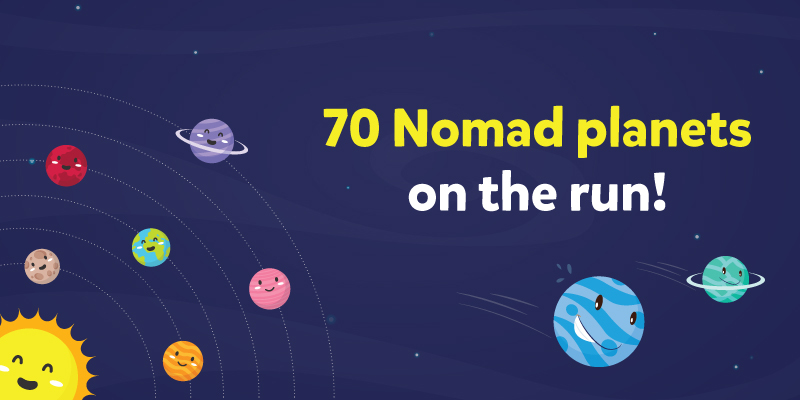
How many planets are there in the solar system? Eight, right? And in the Milky Way? At Least 100 billion, astronomers said in 2020.
In December 2020, some powerful telescopes from the European Southern Observatory (ESO) found out that there could be a few more. A team of astronomers from Austria, led by Núria Miret-Roig have found a record-breaking haul of new planets in the Milky Way!
However, these newly-discovered planets are a bit different from the regular ones that orbit a star. They are on their own in the Milky Way galaxy. These independent heavenly bodies are called ‘rogue planets’ or ‘nomad planets.’ And there are at least 70 of them, scientists say.
Experts believe that this is the largest group of rogue planets ever discovered. They are excited that this discovery will help them learn more about the origins and traits of these nomads. That’s intriguing, right?
Let’s learn more about these nomad planets.
As already mentioned, these rogue planets are lurking far away from any star. This means that they would be impossible to spot, right? If you recall what you may have learnt in your science lessons, planets don’t emit light on their own and need a star to illuminate them. So, without any star near them, how did they get discovered?
Apparently, if the planets are young enough, they are still hot enough to emit light! And by young, we mean JUST a few million years old! Planets are really really old, aren’t they?. So, when you use sensitive cameras on large telescopes, you can spot them.
This is the method that the scientists used to discover these nomad planets. They also used data from over 20 years from several ground-based and space telescopes. Some of them are really powerful and precise instruments, including the European Space Observatory’s aptly named Very Large Telescope in Chile and the European Space Agency’s Gaia satellite.

Atleast 70 rogue planets are found. Courtesy: European Space Organisation website
They observed the motion and the light emission of these planets using millions of sources that appeared in the data.
These rogue galactic bodies are all quietly going about their business in a star-forming region near the Sun, located within the Scorpius and Ophiuchus constellations. They were quite big! The scientists estimate the size to be many times bigger than Jupiter.
And while they have found 70, they estimate that up to 170 such planets are still waiting to be discovered.
This is so exciting, right? How many more of them are we going to unearth?
Before going into the exciting prospects that this discovery presents, we need to understand our journey of discovering rogue planets.

More rogue planets are being discovered Courtesy: European Space Organisation
The first time scientists caught sight of rogue planets was in 2012, through a method called microlensing. It involves watching foreground objects move in front of background stars. In this method, you bend the distant star’s light in ways that can reveal the planet’s mass and other features. It was a free-floating object with the mass of a planet, around 100 light-years away from Earth. It was called CFBDSIR2149 (not the easiest name to remember)!
The next instance was in October 2020, when astronomers discovered an Earth-sized rogue planet in the galaxy! Some of them believe that this rogue planet could be capable of hosting life.
The team of astronomers hopes that by studying the large group of rogue planets, they will be able to identify their origins and how they formed and evolved. Studying these newfound planets will help them understand how these nomads in general are formed and how they are able to fly solo.
For future expeditions, they have their hopes set on European Space Observatory’s upcoming Extremely Large Telescope (ELT), which is under construction in the Chilean Atacama Desert. It’s due to start observations later this decade, around 2027. Aren’t you excited to learn more about the nomad planets out there and their traits?
Now that you have learnt about the rogue planets, we have a question for you. Do you think it’s right to call these nomads ‘planets’ if they don’t revolve around a star? Share your answers in the comments below.
Aparna is a mom, singer and dreamer. At BYJU'S, she writes stories about learning for children. She believes in the power of music, especially ghazal, the magic of the universe and happy learners. When not writing or singing, you will find her intensely engaged in conversations about life and the power of words.
Comments
Alokendra Mandal
January 15, 2022
If we see the literal meaning of the word ‘planet’ then it is derived from planasthai, a Greek verb that means “to wander.”
Although till the discovery of rogue planets we use the term ‘planet’ only for visible celestial bodies which appeared to move independently of the fixed stars and of a certain mass but that as per the literal meaning of planet i.e. to wander, I think it’s perfectly fine to call them planets or more precisely rogue planets. Here the literal meaning of ‘Rogue’ means behaving differently from other similar people or things, and think this rogue term needs to be changed to a more precise term.
Antony
January 14, 2022
They should be called planets because they formed in a star system and got kicked out by larger planets in their star system where they formed. They are somewhat like dwarf planets which almost but not fully fullfill the definition of a actual planet .